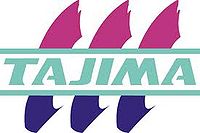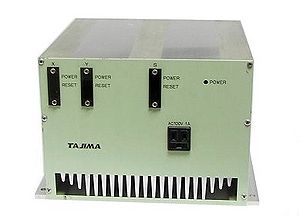Difference between revisions of "Portal:Tajima"
m |
|||
| (28 intermediate revisions by 2 users not shown) | |||
| Line 1: | Line 1: | ||
Welcome to the Tajima portal. | [[File:Tajima_logo.jpg|200px|right]] | ||
Welcome to the '''Tajima embroidery machine''' portal. | |||
[[ | '''Tajima''' is a manufacturer of single and multi-head [[Industrial/Commercial_Embroidery_Machine|embroidery machines]]. Tajima is based out of Japan. TAJIMA embroidery machines are supplied to the market by the '''TAJIMA Group''' which is made up of three companies: Tokai Industrial Sewing Machine Co. Ltd. which handles manufacturing, Tokai Technical Center which is involved in product design and development, and Tajima Industries Ltd. which handles the sales of embroidery machines for the domestic and overseas market. Tajima is one of the most well-known brands in the embroidery machine industry. | ||
Tajima Embroidery Machines (China) Co., Ltd. was established in 2001 in Jieyang, Guangdong, China, to manufacture machines in China. | |||
Tajima [[embroidery machine | Tajima has produced embroidery machines with 1, 2, 4, 6, 8, 10, 12, 15, 20 and 24 heads. In The United States most Tajima models are 1, 2, 4, 6 and 12 head. Most the 8 head machines and machines larger than 12 heads were more common in other countries. Very few 8 heads can be found in the United States but are much more common in Asian countries. Tajima has produced machines with 1, 3, 4, 6, 9, 12 and 15 needles. Machines with 6 needles are common in the very early 1990s. 9 needle machines became popular during the mid 1990s. Late 1990s to around 2010 most machines were 12 needles. 15 needle machines are standard now. Tajima machines with less than 6 needles are generally specialty machines. | ||
==History, origin and sales== | |||
The Tajima brand rose to popularity in the United States between the very late 1980s and the very early 1990s. The early model Tajimas produced till around 1996 had a greenish color scheme. Around 1996, Tajima machines changed from the light green color scheme (with dark green logo) to their more common white color scheme with a green, pink and blue logo (see above). Tajima, along with [[Barudan]] of Japan, became a top two embroidery machine maker in the USA. Both Barudan and Tajima continue to be the two leading makers of embroidery machines for the United States market. | |||
Tajima continues to lead sales in most of the west and south of the USA whereas Barudan leads sales in the north and east. Most of the rest of the United States is evenly divided among the two major embroidery machines (Tajima and Barudan). Tajimas are more commonly seen around Mexico and most of Central America whereas Barudan tends to lead sales in countries such as Colombia, Peru, Venezuela. Countries such as Argentina, Canada, Brazil, and Chile are divided among both Tajima and Barudan for popularity rights. | |||
Tajima machines originally ran off paper punch cards from the 1970s till the 1980s when they were replaced by paper tape. Paper tape was soon replaced by floppy disk drives. Most all Tajima machines today are now run off USB drives. | |||
==Machines and Machine Info== | |||
Tajima has been manufacturing embroidery machines for decades. Some of the models include: | |||
*[[Tajima TMM]] | |||
*[[Tajima TMEF]] | |||
*[[Tajima TME-HC]] | |||
*[[Tajima TME-DC]] | |||
*[[Tajima TMFD]] | |||
*[[Tajima TMEX & Tajima TMFX]] | |||
*[[Tajima TEHX]] | |||
*[[Tajima TFHX-IIC]] | |||
*[[Tajima TFMX-C]] | |||
*[[Tajima NEO]] | |||
*[[Tajima_NEO#TEMX-C_.28Neo_Plus.29_Series|Tajima TEMX-C]] | |||
==Tajima Electronics== | |||
[[File:Tmfxpower2.jpg|thumb|right|alt=Tajima TMFX Power Box|Tajima TMFX Power Box]] | |||
The [[Tajima Electronics]] page contains a list of circuit boards and electronics on the Tajima Embroidery Machines. | |||
==Add-ons== | |||
Other additional accessories or upgrades | |||
*[[Floppy To USB]] | |||
*[[Embroidery Black Box]] | |||
==Other Equipment== | |||
In addition to Tajima producing single and multi-head embroidery machines, Tajima also produces chenille machines (TMCE), and machines with sequin devices. | |||
The also make Lock Stitch machines (TMLG) and Laser Cut machines (TLFD) | |||
==Software Extensions== | |||
The [[.dst]] file format is the most common software extension for Tajima software and machines. Tajima popularized the .dst file format to such an extent that the file format has become something of a universal standard for embroidery design files. Even so, Tajima embroidery machines use several other [[embroidery software formats]]. | |||
{{tajimaFooter}} | |||
Latest revision as of 20:57, 24 May 2016
Welcome to the Tajima embroidery machine portal.
Tajima is a manufacturer of single and multi-head embroidery machines. Tajima is based out of Japan. TAJIMA embroidery machines are supplied to the market by the TAJIMA Group which is made up of three companies: Tokai Industrial Sewing Machine Co. Ltd. which handles manufacturing, Tokai Technical Center which is involved in product design and development, and Tajima Industries Ltd. which handles the sales of embroidery machines for the domestic and overseas market. Tajima is one of the most well-known brands in the embroidery machine industry.
Tajima Embroidery Machines (China) Co., Ltd. was established in 2001 in Jieyang, Guangdong, China, to manufacture machines in China.
Tajima has produced embroidery machines with 1, 2, 4, 6, 8, 10, 12, 15, 20 and 24 heads. In The United States most Tajima models are 1, 2, 4, 6 and 12 head. Most the 8 head machines and machines larger than 12 heads were more common in other countries. Very few 8 heads can be found in the United States but are much more common in Asian countries. Tajima has produced machines with 1, 3, 4, 6, 9, 12 and 15 needles. Machines with 6 needles are common in the very early 1990s. 9 needle machines became popular during the mid 1990s. Late 1990s to around 2010 most machines were 12 needles. 15 needle machines are standard now. Tajima machines with less than 6 needles are generally specialty machines.
History, origin and sales
The Tajima brand rose to popularity in the United States between the very late 1980s and the very early 1990s. The early model Tajimas produced till around 1996 had a greenish color scheme. Around 1996, Tajima machines changed from the light green color scheme (with dark green logo) to their more common white color scheme with a green, pink and blue logo (see above). Tajima, along with Barudan of Japan, became a top two embroidery machine maker in the USA. Both Barudan and Tajima continue to be the two leading makers of embroidery machines for the United States market.
Tajima continues to lead sales in most of the west and south of the USA whereas Barudan leads sales in the north and east. Most of the rest of the United States is evenly divided among the two major embroidery machines (Tajima and Barudan). Tajimas are more commonly seen around Mexico and most of Central America whereas Barudan tends to lead sales in countries such as Colombia, Peru, Venezuela. Countries such as Argentina, Canada, Brazil, and Chile are divided among both Tajima and Barudan for popularity rights.
Tajima machines originally ran off paper punch cards from the 1970s till the 1980s when they were replaced by paper tape. Paper tape was soon replaced by floppy disk drives. Most all Tajima machines today are now run off USB drives.
Machines and Machine Info
Tajima has been manufacturing embroidery machines for decades. Some of the models include:
- Tajima TMM
- Tajima TMEF
- Tajima TME-HC
- Tajima TME-DC
- Tajima TMFD
- Tajima TMEX & Tajima TMFX
- Tajima TEHX
- Tajima TFHX-IIC
- Tajima TFMX-C
- Tajima NEO
- Tajima TEMX-C
Tajima Electronics
The Tajima Electronics page contains a list of circuit boards and electronics on the Tajima Embroidery Machines.
Add-ons
Other additional accessories or upgrades
Other Equipment
In addition to Tajima producing single and multi-head embroidery machines, Tajima also produces chenille machines (TMCE), and machines with sequin devices.
The also make Lock Stitch machines (TMLG) and Laser Cut machines (TLFD)
Software Extensions
The .dst file format is the most common software extension for Tajima software and machines. Tajima popularized the .dst file format to such an extent that the file format has become something of a universal standard for embroidery design files. Even so, Tajima embroidery machines use several other embroidery software formats.
Tajima Legend
Tajima used several codes in their models that described basic features of the machines. The letters in the model number usually
- TME
- Machines with TME in their model without any other letters (numbers only) is a very late 1970s - 1990 flat only machine.
- TME-C
- Predecessor to the TME, a Tajima machine with a C in it represents Cylinder (tubular) embroidery. Therefore machines with the letter C in their model, have removable tables.
- TME-HC, TMEF-H, H
- Models with H in their model have the H model control panels. A TME-HC is an Arm Type machine with removable tables and the H model control panel. A TMEF-H machine is a flat machine with the H model control panel.
- TMEF
- Machines with the F code are Bridge Machine (not arm type). If there are not more letter codes then this machine is a flat only machine (does not to tubular or caps).
- TMM
- TMM machines were collaboration Melco and Tajima machines. These machines have a Melco control panel/keyboard.
Tajima Years, Date or Age
The year of the Tajima machine can usually be found on a sticker behind the machines control panel or power boxes. These years are usually the year that the machines electronics were Quality Control checked at the Japan factory. The months listed on these stickers will probably be different. It usually took about 3 months from production to delivery to the original customers location. Later models had the production year stamped on the data plate.
If the machine is old and does not have a sticker, then the machine is probably older than 1990.
Buying
Tajima embroidery machines are probably one of the best machines on the market. They are more expensive that most all competing models but, they are very solidly built and have a good resell market. There are a lot of embroidery machine technicians available world wide and parts are pretty easy to find even for older models.
Selling
TheEmbroideryWarehouse buys and sells most every make and model of Tajima embroidery machines located within the continental USA. They also purchase parts, parts machines, salvage machines and most everything else related to embroidery equipment.

